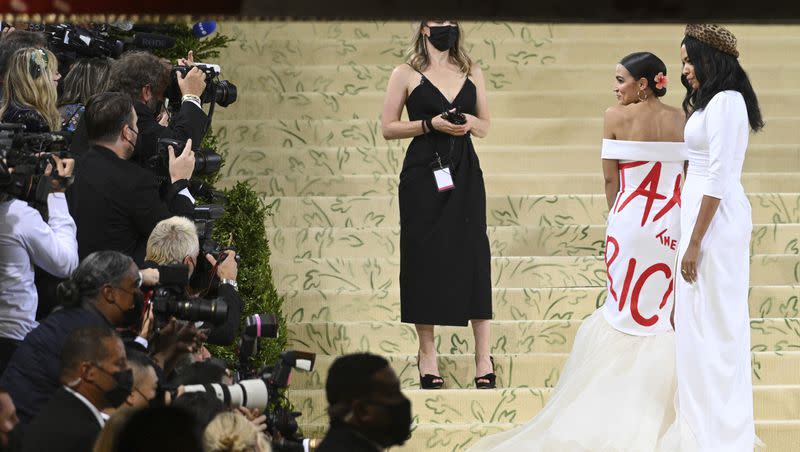Opinion: What Democrats get wrong with ‘tax the rich’ mantra

You have heard it many times before from people like President Joe Biden and presidential wannabe Bernie Sanders. And, with an election year looming, you’re bound to hear it again.
“The rich should pay their fair share.”
Two years ago, Rep. Alexandria Ocasio-Cortez, D-N.Y., was spotted at the Met Gala, an event for the wealthiest of the wealthy, wearing a white dress emblazoned with the message, “Tax the Rich” in bright red.
That’s a real crowd pleaser, but it can’t solve the nation’s problems.
A new study from the Manhattan Institute illustrates how ridiculous, not to mention impossible, that notion is.
First of all, the nation’s top-earning quintile earns 58% of all the income and pays 69% of all federal taxes, including 90% of all income taxes. Meanwhile, the top 1% of earners brings home 18% of all income but pays a quarter of all federal taxes and 40% of all income taxes.
At the other end of the scale, the bottom 60% of all earners makes 23% of all income but pays only 13% of all federal taxes, including less than zero combined income taxes.
This is an inconvenient truth many politicians, particularly on the left, don’t want people to hear. It even offends regular hardworking folks who don’t like the implication that they aren’t pulling their weight.
And, let’s face it, no politicians would campaign on a platform of making the poor and middle class pay their fair share. But anyone who looks at the nation’s runaway spending with a clear eye would see it’s impossible to fix things without everyone paying more.
Related
In the 2012 presidential election, Mitt Romney took a lot of criticism for telling a roomful of wealthy donors at a fundraiser that 47% of Americans “are people who pay no income tax.”
I suppose it did sound a bit elitist. But the fact checker politifact.com examined it and rated Romney’s statement as true, with the comment that a 2009 report by the Joint Committee on Taxation had found an even larger percentage paying nothing.
The authors of the report want to make one thing clear. They aren’t shilling for any political point of view.
“In order to avoid the partisan misrepresentations that typify tax policy debates, it is important to clarify, at the outset, that this report is not a conservative anti-tax manifesto,” the report says. “It does not argue that upper-income taxes should not be raised at all. Nor does it claim that all tax cuts pay for themselves.”
Instead, it “employs consensus economic modeling and research to build a more realistic framework for taxing the rich — and to rein in the unrealistic perception that taxing the rich can sufficiently eliminate budget deficits and finance the progressive agenda.”
That realistic framework, however, is elusive. The rich have more choices when it comes to taxes. And there is truth to the notion that higher rates on the rich and on corporations can have a negative effect on job creation and investments.
The report quotes economist Martin Feldstein, who said, “I dislike budget deficits as much as anyone else. But would I really want to give up, say, $1 billion of GDP in order to reduce the deficit by $100 million?”
Of course not.
Related
The report also debunks a few myths, including that European nations tax wealthy citizens more without hurting their economies. No, the report concludes, European tax revenues are driven by more broad-based income and consumption taxes. They have national sales taxes, or value-added taxes, that hit the poor and middle classes hardest.
And no, the 90% marginal tax rates the United States imposed on high earners in the 1950s didn’t bring in much additional revenue.
And yet, to be fair, this generation did not invent the “tax the rich” slogan. It’s worth remembering how, when the income tax was first levied in 1913, the idea was to tax only the rich. Every individual earning up to $3,000 (roughly $92,000 in today’s dollars), and every couple earning up to $4,000 was exempted. People who earned up to $20,000 were taxed at 1%.
Exempting roughly the lowest earning 60% today is in keeping with that idea, except for all the paperwork.
Only, we can’t fix our current problems that way. And while cuts are certainly necessary, we can’t fix things that way, alone, either. This year’s budget deficit is at 6.62% of GDP, and the national debt, at $33 trillion, is equal to 123.7% of GDP, according to usdebtclock.org. That’s a huge imbalance.
The 18th century French economist Anne Robert Jacques Turgot is often credited with saying that the art of taxation is to pluck the hen without making it squeal. That’s OK when the hen is wealthy. No one seems to care, then. But Americans have passed a point where widespread squealing can’t be avoided.
Or, as the Manhattan Institute report puts it, “Everyone wants a free lunch, and taxing the rich has always been popular with voters — but even moderately informed voters understand that such a promise is mathematically — and economically — absurd.”
That’s worth remembering as next year’s election rhetoric begins to heat up.

